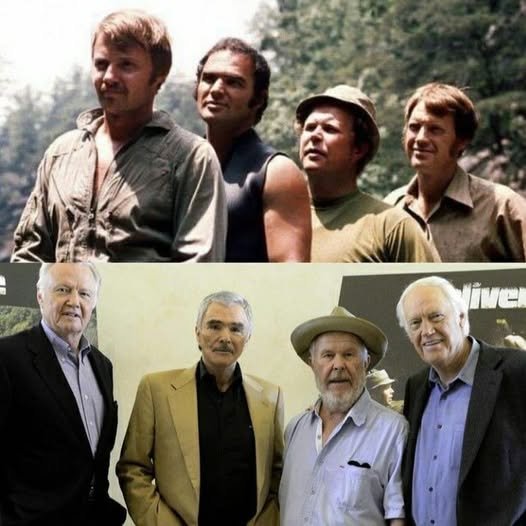Deliverance (1972): A Timeless Survival Thriller That Redefines Human Nature
Deliverance (1972), directed by John Boorman, is one of the most intense and enduring survival thrillers in cinematic history. Adapted from James Dickey’s 1970 novel, Deliverance explores the raw, primal instincts of four men who embark on a seemingly innocent weekend canoe trip, only to face life-or-death challenges in the wild Appalachian wilderness.
The Plot: A Descent into Survival
The story centers around four friends—Lewis (Burt Reynolds), Ed (Jon Voight), Bobby (Ned Beatty), and Drew (Ronny Cox)—who decide to canoe down the remote Cahulawassee River in Georgia before it is dammed and flooded. What begins as an exciting and adventurous weekend quickly transforms into a nightmare as they encounter a series of shocking events that force them to confront the harsh realities of nature and human vulnerability.
The men are thrust into a fight for survival when they are ambushed by two violent mountain men, leading to one of the most shocking and infamous assault scenes in film history. This brutal moment forces the characters to question their morality, face their deepest fears, and make life-altering decisions that will haunt them forever.
Exploring Human Nature and Vulnerability
Deliverance is renowned for its unflinching exploration of human vulnerability, societal breakdown, and the primal survival instincts that emerge when civilization’s safety net disappears. The turning point of the film, which sees the men come face-to-face with their attackers, challenges their preconceived notions of what it means to be a man and exposes the fragility of modern civilization.
The film highlights the psychological tension that builds throughout their journey as the men struggle with their own limitations and fears. Deliverance delves into the complexities of human nature and survival in a way that few films have dared to explore.
Cinematic Excellence and Visual Mastery
Visually, Deliverance is stunning, thanks to the expertise of cinematographer Vilmos Zsigmond. The Appalachian wilderness is portrayed with a mix of beauty and menace, offering both breathtaking and threatening landscapes. The Cahulawassee River becomes a character in itself, representing both the serenity and danger that the men must navigate throughout their journey.
The film’s cinematography elevates the sense of tension and dread, with the river’s rapids acting as a metaphor for the uncontrollable forces of nature. Each shot serves to remind the audience of how small and insignificant humanity can feel when pitted against the raw power of the natural world.
The Iconic “Dueling Banjos” and Cultural Divide
One of the most memorable aspects of Deliverance is the haunting “Dueling Banjos” duet, which underscores the cultural divide between the city men and the rural locals they encounter. This iconic piece of music highlights the tension between the characters’ unfamiliarity with their surroundings and the hostility they face from the mountain men.
The banjo duel has since become a symbol of the film, representing the clash between the modern world and the untamed, primitive forces lurking in the wilderness.
Stellar Performances That Define the Film
The performances in Deliverance are nothing short of exceptional, particularly Burt Reynolds as Lewis, the rugged, survivalist leader of the group. Reynolds’ portrayal of the self-reliant and often stoic character is a standout, showing the complexity of man in the face of extreme challenges. Jon Voight’s portrayal of Ed, the introspective and morally conflicted character, offers a sharp contrast, as he grapples with the impact of the violence that unfolds.
Both actors deliver powerful performances that anchor the film’s emotional depth and tension, making the journey all the more gripping and impactful.
Deliverance’s Legacy: A Classic Survival Thriller
Deliverance became both a critical and commercial success, earning three Academy Award nominations, including Best Picture. Its themes of survival, human fragility, and the breakdown of societal norms resonated deeply with audiences and critics alike. The film’s unflinching realism, psychological tension, and exploration of human nature continue to make it a classic in the survival thriller genre.
Even more than 50 years after its release, Deliverance remains a cinematic milestone, influencing filmmakers and moviegoers alike. Its legacy lies in its unrelenting portrayal of the struggle for survival in the wilderness and its deep dive into the dark complexities of human nature.
Conclusion: Why Deliverance Remains a Must-Watch Classic
In a world where survival thrillers are often formulaic and predictable, Deliverance stands as a masterclass in tension, psychological depth, and realism. The film’s exploration of human vulnerability, its haunting imagery, and its unforgettable performances make it a timeless classic that continues to captivate audiences around the globe.
If you haven’t seen Deliverance yet, it’s time to experience this gripping journey through the wilderness and witness the struggle for survival like never before.
